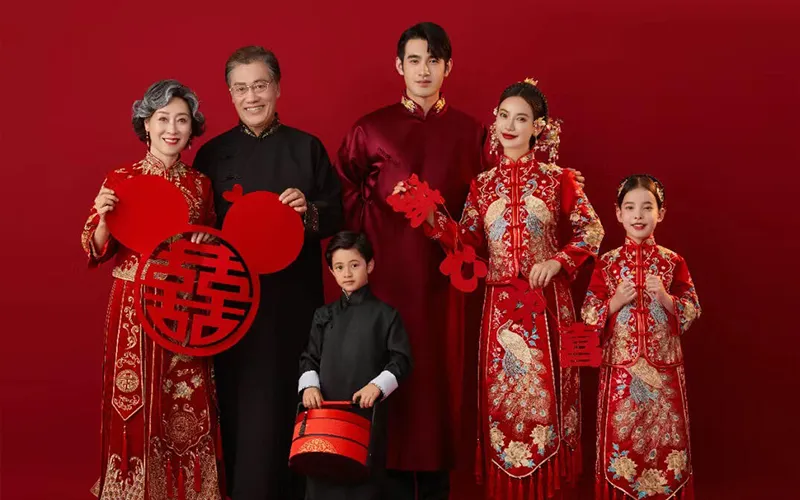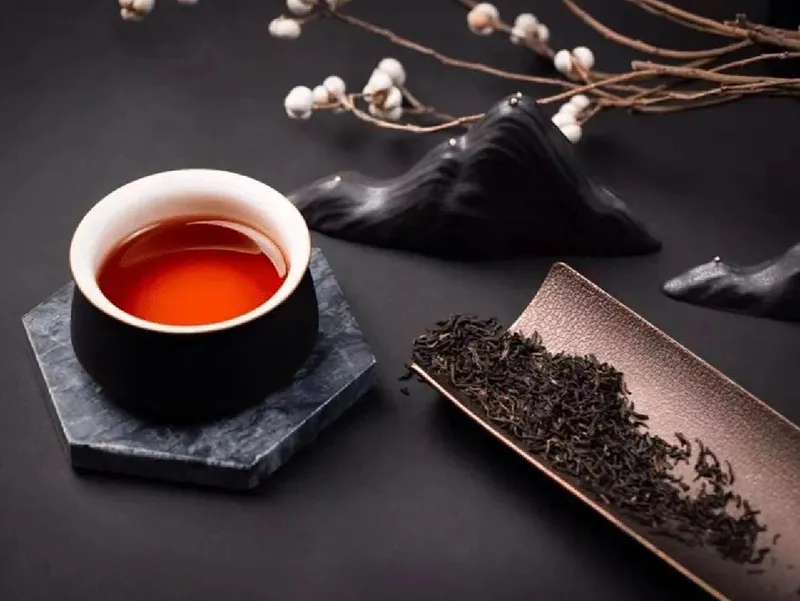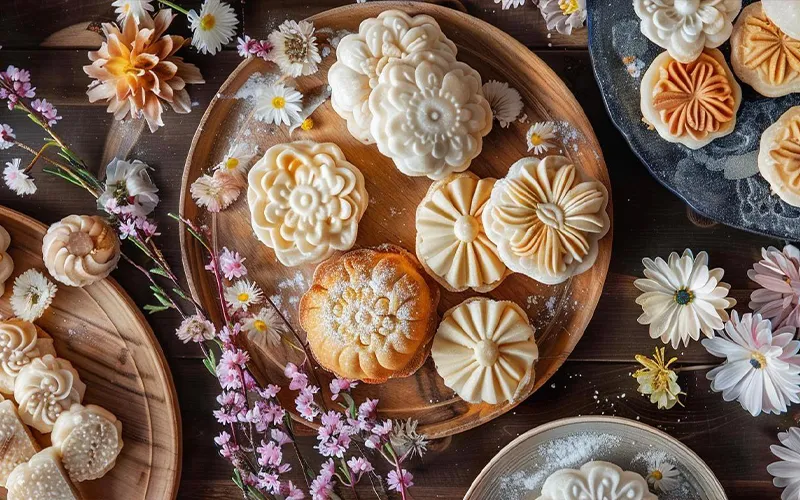Chinese Festivals
Chinese festivals can be divided into three kinds. One is the traditional festivals, such as Chinese New Year and Mid-Autumn Festival. The second one is the public holidays, for example, National Day. The third one is the ethnic festivals, those are celebrated by 55 ethnic minorities in various ways all over China.
Due to the diverse of Chinese culture, each festival has its own character. It will be fun if you can visit China during the festival time because you will have a great chance to experience like Chinese people. Almost every festival has its own unique origins and customs which reflect the traditional practices and morality of the whole Chinese nation and its people. And all festivals showcase a blend of entertainment, cuisine, music, and rituals that vary widely across different regions, reflecting the diverse ethnic backgrounds within China.
-Chinese Spring Festival(Traditional Festival and Public Holiday)
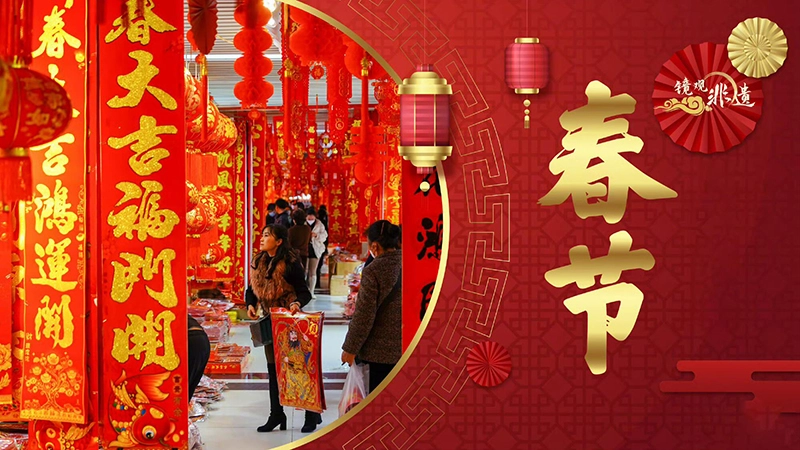
Chinese Spring Festival, also known as Chinese New Year, is the most important festival in China because it is the first day of Chinese lunar calendar which is often in February. As a Chinese saying goes, a good beginning is a half of success. So everyone makes his best wish for a good beginning of a new year.
As the same as the Christmas in Western, Chinese Spring Festival was a time to honor deities and ancestors in ancient time and it has also become a time to feast and visit family members now. About half a month before Spring Festival’s Eve, people will start to sweep up the house and purchase many kinds of new year’s items to prepare the big dinner and new year’s decorations. People who are working outside their hometowns will begin to book their flight tickets or train tickets back home at the same time, especially young generation. Parents decorate their house with lanterns and window paper. They will prepare a feast supper for the whole family on New Year’s Eve. It is the most essential moment for a Chinese family to enjoy the harmony of a family together. The meal will usually last for several hours, and then people will stay up late on New Year's Eve with fireworks until the first day of the new year arrives. Dumplings are what Chinese people in the northern part must eat. And for the next day, children greet New Year’s greeting to the elders and are handed out red packets.
Each year is associated with a specific zodiac animal, and in 2024, it will be the Year of the Dragon, a symbol of strength, fortune, and vitality, adding even more excitement to this cherished cultural festival. For the coming 2015, it is the year of the Snake.
Travel Tips for Chinese Spring Festival
Book your tickets or room in advance if you are going to China during the Chinese Spring Festival. Two weeks before the Spring Festival is the peak time for public transportation since people return to their hometowns or take a vacation from where they work. We call it a Spring Festival Transfer. As a result, you had better book your tickets and rooms as early as possible to avoid the high cost even a shortage. Furthermore, the airports and railway stations are fully of people at that time. Please be ready for crowded and take care of your belongs.
Learn some oral Chinese words when you meet new Chinese people or friends. You can demonstrate your politeness and respect for Chinese culture. Xin Nian Hao (Happy New Year) is a common greeting that people use a lot during the period of Spring Festival.
-Dragon Boat Festival(Traditional Festival and Public Holiday)
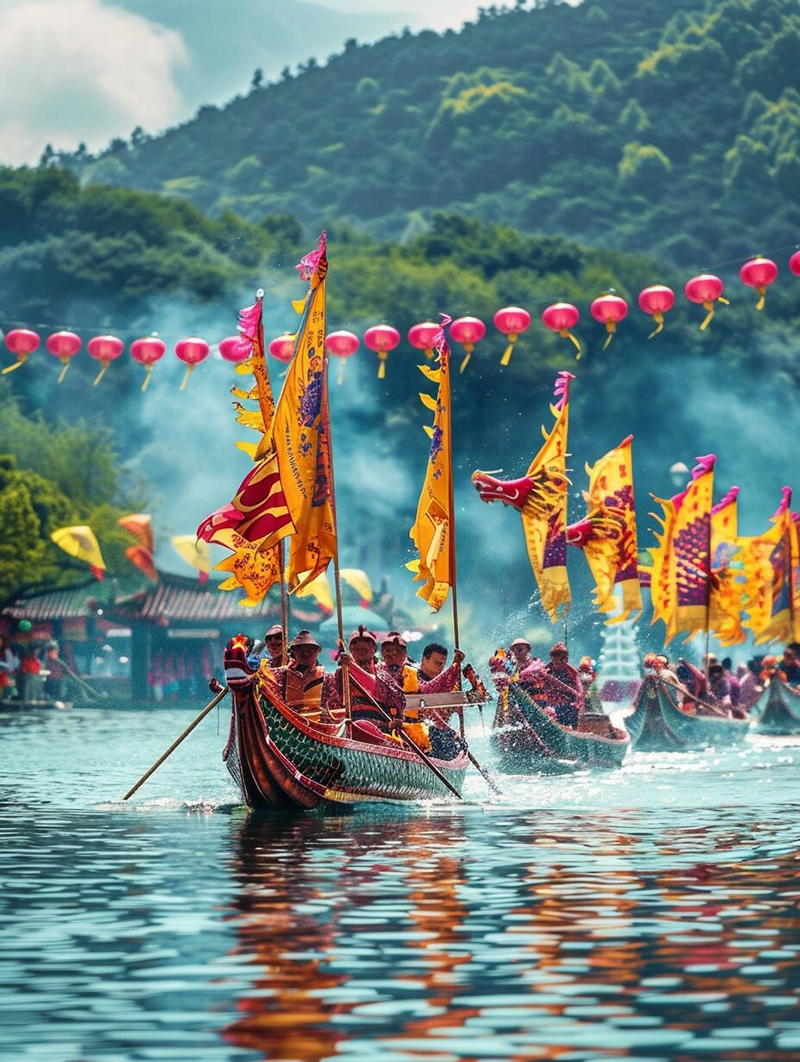
Dragon Boat Festival falls on the fifth day of the fifth lunar month, which is in late May or June on the Chinese lunar calendar. It is a 3-day public festival. Along with the Spring Festival, Tomb-Sweeping Day, and Mid-Autumn Festival, Dragon Boat Festival is one of the four top traditional Chinese festivals. The must-do thing for this traditional festival is to eat Zongzi, a dumpling made of sticky rice wrapped with bamboo or green leaves.
There are two sayings about the origin of Dragon Boat Festival. One is evidenced that the Dragon Boat Festival is celebrated to commemorate the death of Qu Yuan, a famous Chinese poet, and minister known for his patriotism and contributions to classical poetry, who eventually became a national hero.
The other origin is related to the fifth lunar month which was known to ancients as the 'month of poison'. Before the fifth lunar month, it is spring when people would easily fall ill and epidemics spread. People wish to prevent diseases and keep evil spirits away so that they do lots of things on Dragon Boat Festival. These customs are well kept till today as a part of Chinese traditions. Therefore, Dragon Boat Festival was originally regarded as a traditional medical and health festival. It is a festival for people to come against diseases and poisonous insects.
Here are traditions Chinese people do on Dragon Boat Festival:
Hanging Chinese mugwort and calamus - Mugwort leaves and calamus are used medicinally in China to deters flies and mosquitoes.
Drinking realgar wine - In ancient China, people believed that realgar was an antidote for all poisons, and effective for killing insects and driving away evil spirits.
Wearing perfume pouches- Parents usually prepare perfume pouches for their children. These little bags with colorful silk cloth are filled with perfumes or herbal medicines.
Having Zongzi (sticky rice dumplings) - Zongzi are the most traditional Dragon Boat Festival food with different flavors. They are made of sticky rice filled with meats, beans, dates and nuts. All are wrapped in triangle or rectangle shapes within bamboo or reed leaves and tied with soaked stalks or colorful silky cords.
Dragon boat racing - It is the most popular activity of Dragon Boat Festival no matter for audiences or competitors. It was a way to worship the Dragon God or Water God. Now, people treat it as the symbol of good luck for the champion. The wooden boats are shaped and decorated in the form of a Chinese dragon.
Travel Tips for Dragon Boat Festival
One day holiday is for Dragon Boat Festival in China now. If you are lucky enough, you could enjoy a dragon boat racing at a river in your traveling city on that day. It is very precious to have a look because even local people will not enjoy this racing regular now. Just yell loudly “Jia You(Come on)with all other Chinese.
Once again, try to book your tickets and rooms as early as you can to guarantee your traveling.
-Mid-Autumn Festival(Traditional Festival and Public Holiday)
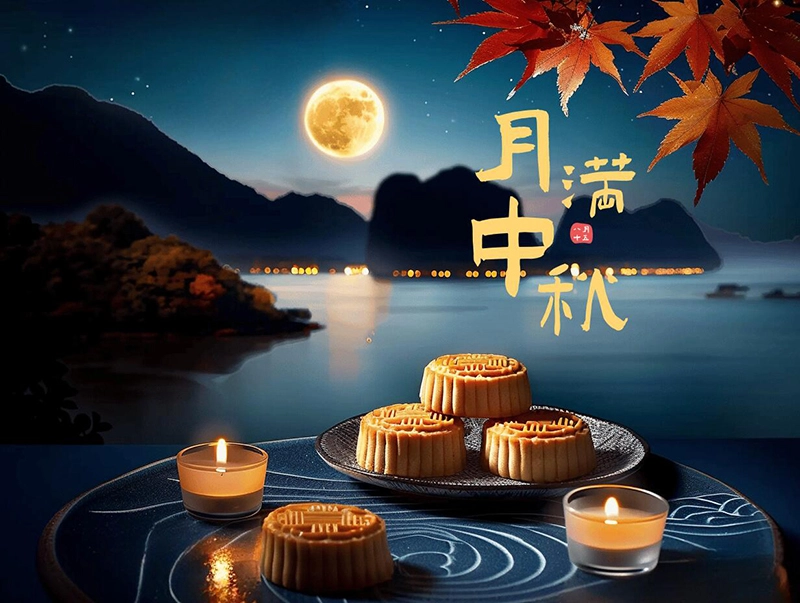
As the second most important festival in China after Chinese New Year, Mid-Autumn is an official public holiday and traditional festival. It is also called the Mooncake Festival or the Moon Festival.
In ancient China, Mid-Autumn Festival was a royal sacrificial ceremony associated with moon worshiping and agricultural activities. The changes in the lunar phases provided guidance for the farming schedule; so people believed that worshiping the moon could bring a good harvest.
Nowadays, Chinese people don’t worried about the food supplies but the Mid-Autumn Festival is still significant because the full moon during the festival is a symbol of family reunions, similar to Thanksgiving. They celebrate it by gathering for dinners with family members, worshiping and appreciating the moon, lighting paper lanterns, eating moon cakes, etc.
There is a famous Chinese legend about the moon, Change’s Fly to the Moon. The rabbit, the osmanthus tree and the Godness Change became synonymous with the moon in Chinese culture.
Travel Tips for Mid-Autumn Festival
Mid-Autumn Festival is a public holiday with 1 day in China so there are also more people choose to travel around at this festival. You are highly recommended to book your tickets and rooms in advance.
Luckily, you have a chance to taste the mooncake at any Chinese restaurant on the day of Mid-Autumn Festival. Some restaurants will offer free mooncakes. If not, it is very easily for you to buy a small box of mooncake at any shops. It is a sweet and yummy desert you should not miss.
-National Day(Public Holiday)
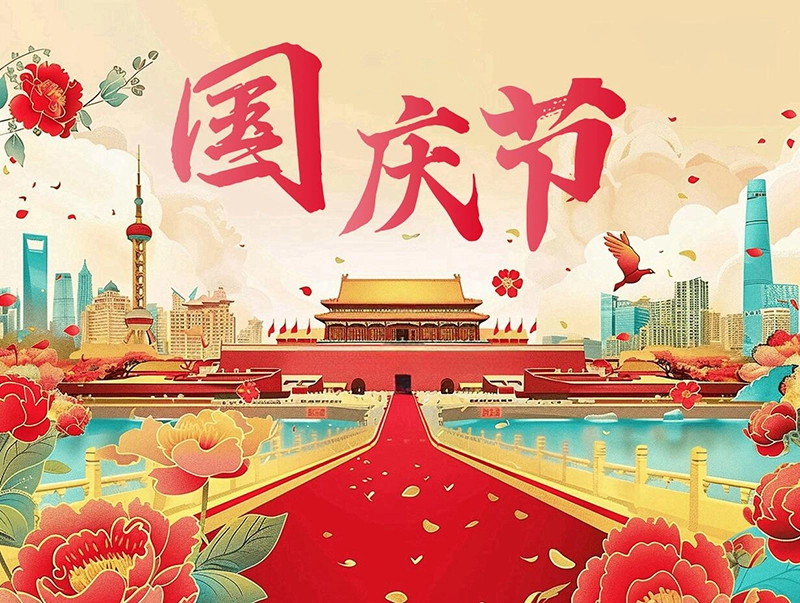
National Day refers to the holiday from Oct.1st- 7th ,also known as Golden Week in China. As the name shows, it is in memory of the foundation of new China since 1949. It is the most popular public festival in China. The street are decorated with flowers and red flags everywhere. Most families will choose this holiday to travel around the country.
Travel Tips for National Day
Every year, the famous traveling cities and attractions are full of people. Hotels offer a special cost of National Day. If you can adjust your traveling date, you had better choose the time before or after National Day to avoid the peak travelling time in China.
-Sister's Meal Festival(Ethnic Minority Festival)
Sister's Meal Festival plays an important role in Miao people's life in China as their No.1 ethnic minority festival where young men and women gather to sing, dance and exchange gifts. The festival is a time for countship and romance, and is a key event in the Miao social calendar. So it was called as the oldest Valentine’s Day of China.
Sister's Meal Festival falls on the 15th day of the third month in the lunar calendar and the celebration usually lasts for 3 days. The Miao ethnic people in southwest China's Guizhou Province, especially in the counties of Taijiang and Jianhe Counties, have the tradition of celebrate this festival.
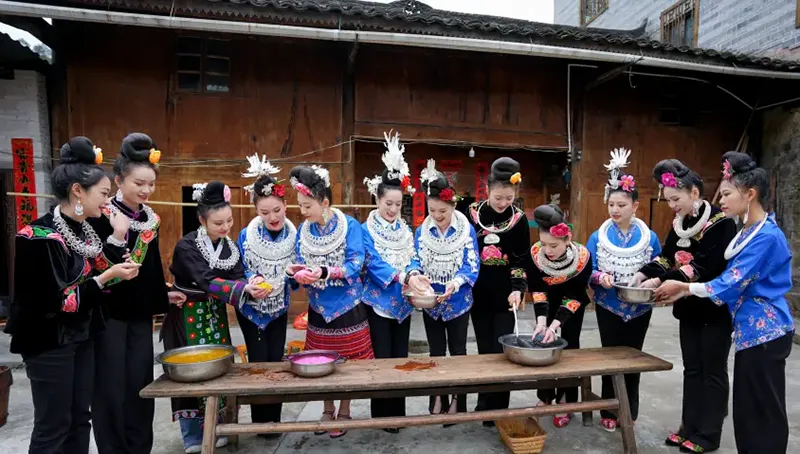
Here are three main activities Miao people would do for Sister's Meal Festival:
1. Eat Sister's Meal(Different colored rice)
Sister’s Meal is made by Miao girls by collecting fresh wildflowers and leaves from the mountains nearby to produce natural coloring in order to dye glutinous rice. Steamed rice is dyed blue, pink, yellow, and white to represent spring, summer, autumn, and winter, respectively. What’s more important, Miao girls puts different plants in different baskets or bags to show their different feelings: a bamboo hook implying a further contact; buds of Chinese toon sprout or parsley symbolizing coming of a marriage and garlic stalk hinting a polite refusal. When man comes to woman’s village and ask for Sister’s Meal, the woman could decide Yes or No by sending the Sister's Rice.
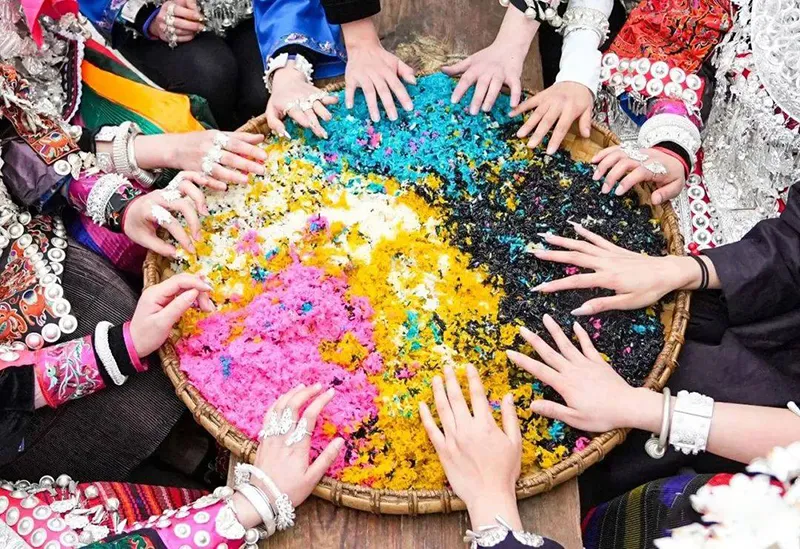
2. Dress-up Beautiful Costumes
For the festival, Miao girls dress up in their holiday best with startling silver headdresses, crowns, and neck rings. According to Miao customs, the larger, heavier, and more plentiful silver ornaments are considered the most beautiful. It is a great honor for girl's beauty to be known to villages nearby.
3. Singing and Dancing Party for Single Males and Females
Miao people like to show their love by singing songs as an asking-and-answering game between single males and females. A single male begins to single out the female if he wants to date out even marry someday. The female accepts or refuse by singing as well. They sing in an antiphonal style with interesting words. When the men can't answer the questions by singing, they lose and should give gifts to the women, and vice versa.
There are also many other activities, including bullfighting, horse racing, traditional Miao performances, and Lusheng music.
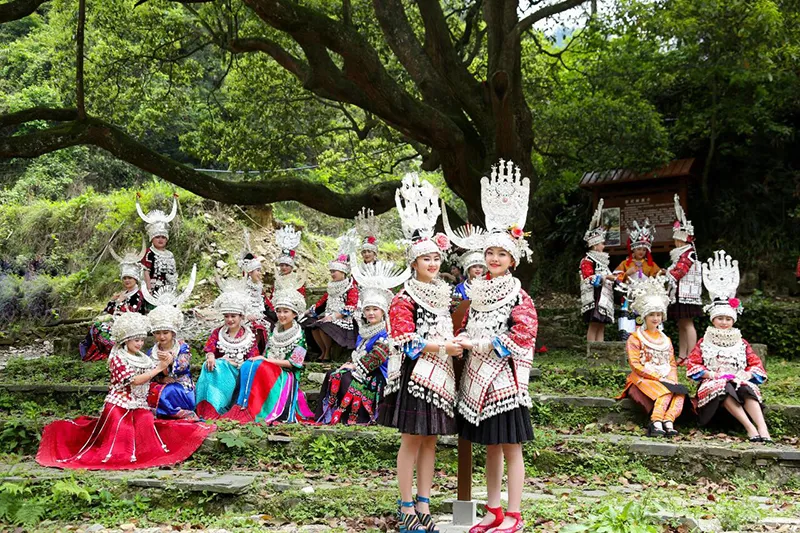
Travel Tips for Sister's Meal Festival
It is very interesting to see the Sister’s Meal Festival by your eyes in spot. You can try to see what a real Sister's Meal Festival in our 6-Day Guizhou Ethnic Discovery Tour . Just visit Guizhou at that time and try to be a local people with them. It is not a national holiday so do not worry too much about the hotel and tickets.
-Tibetan New Year(Ethnic Minority Festival)
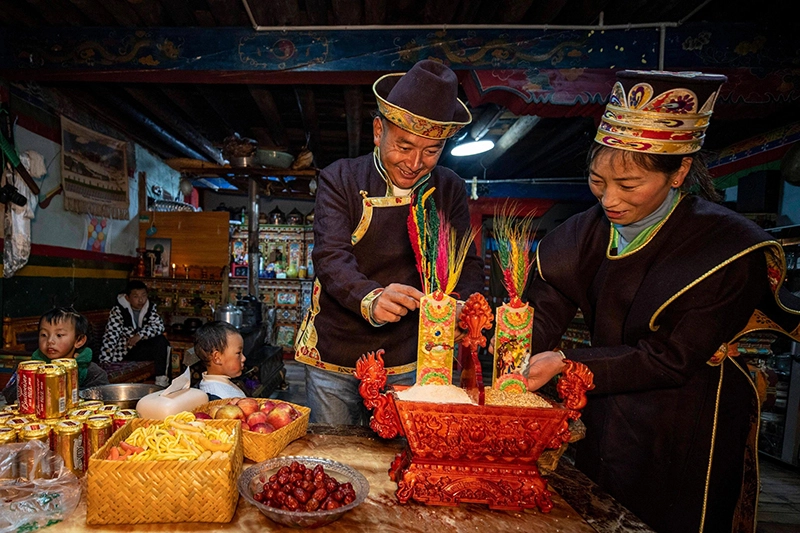
Tibetan New Year, known as "Losar" in Tibetan, is the most important traditional festival for the Tibetan people, equivalent to the Spring Festival of the Han people.
In the Sakya Dynasty in the 13th century, the first day of the first lunar month was designated as the beginning of the New Year, meaning the King's New Year. Since then, the Tibetan New Year has officially become an important traditional festival for the Tibetans and has continued to this day.
The date of Tibetan New Year always falls on a new moon in the first two solar terms — from February 5 to March 5. The celebrations of Tibetan New Year traditionally span from the last 2 days of the old year to the 3rd day of the new year (Feb. 28th to Mar 2nd in 2025).
The activities of Tibetan New Year are very similar to Chinese Spring Festival. From the middle of the last month of the old Tibetan year, people begin to prepare things for the New Year such as food, clothing, toys and daily necessities. Each family will clean the house thoroughly and sprinkle flour outside the gate, on the roof beam and on the kitchen wall, and draw the "Eight Auspicious Symbols" which symbolize auspiciousness and eternity. People also prepare the "Droso - Chema" (a kind of container filled with highland barley flour, ginseng fruit, fried highland barley flowers, etc.), with various highland barley ears, cockscomb flowers and butter offerings inserted on it.
On the evening of the 29th day of the 12th lunar month in the Tibetan calendar, Tibetan people will eat "Guthuk", which is a kind of dumpling - like food. Different things such as stones, wool, chilies, charcoal and coins are wrapped in the Guthuk, and eating different things has different meanings. When the sun is about to set, people pour out all the sewage and dirt on both sides, believing that this is a guarantee for a prosperous population and the growth of all things.
From the second day, people will visit relatives and friends, exchange New Year's greetings and give gifts such as "Droso - Chema". During this period, there will also be various traditional cultural activities and performances such as Tibetan opera and dance, and the whole celebration will last for a period of time.
Travel Tips for Tibetan New Year
It is a regional ethnic minority festival, only for Tibetan people. If you want to experience what the Tibetan New Year is, you could choose the time to go to Tibet. Our 4-Day Lhasa Highlights Private Tour is a good choice for you. The hotels and tickets are a little hard to be booked so you need to decide as early as you can.
-Tibetan Shoton Festival(Ethnic Minority Festival)
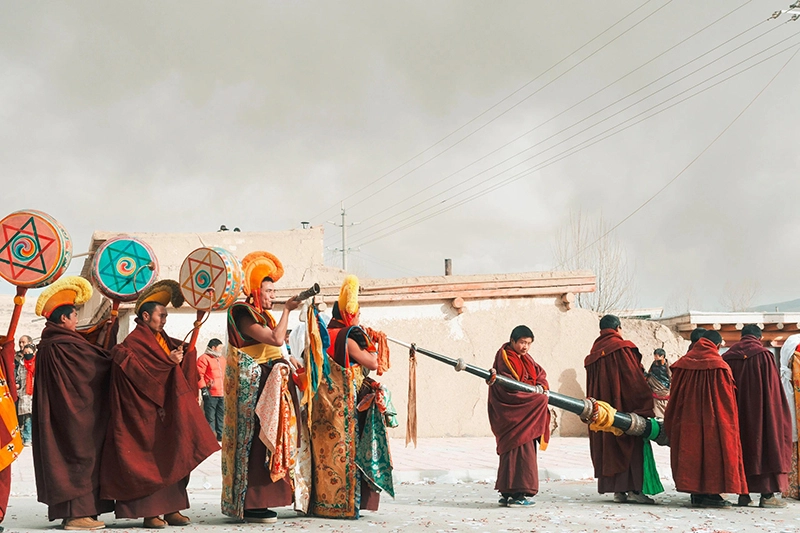
The Tibetan Shoton Festival is a significant and vibrant cultural event in Tibet. "Shoton" means "Yogurt Banquet" in the Tibetan language. It has a long history and profound cultural connotations. The festival's origin is closely related to Tibetan Buddhism. In the past, Tibetan monks had to stay in the monastery for penance during the rainy season (about a month - from the 16th day of the 6th lunar month to the 15th day of the 7th lunar month). This was called the "Summer Retreat." After the retreat, people would offer them yogurt as a welcome treat. Over time, this developed into a grand festival.
The Shoton Festival usually lasts for several days. It falls around the end of June or the beginning of July in the Gregorian calendar, according to the traditional Tibetan lunar calendar. It combines religious ceremonies, traditional Tibetan opera performances, and a variety of folk activities.
One of the most solemn and important ceremonies is "Sunning the Buddha." Giant thangka (Buddhist scroll paintings) of Buddha is unfurled on the hillside. Devotees from far and wide come to pay their respects. The thangka can be dozens of meters long and wide, and the colors are extremely vivid. When it is unfurled against the backdrop of the blue sky and green mountains, it is a spectacular sight. The act of sunning the Buddha is considered a way to bring blessings and positive energy.
Tibetan opera is a highlight of the Tibetan Shoton Festival. Many troupes perform various classic Tibetan opera works. The actors wear elaborates and colorful traditional costumes and masks. The unique singing and dancing styles, along with the vivid story - telling, attract a large number of audiences.
As the name implies, yogurt is an essential element of the festival. People gather to taste different kinds of delicious yogurt. The yogurt is usually made from high - quality yak milk, with a thick texture and a unique flavor. It is often served with various nuts and fruits, adding more variety to the taste.
The Tibetan Shoton Festival is not only a religious and cultural celebration but also a platform for people to strengthen social bonds. It reflects the unique religious beliefs and artistic traditions of the Tibetan people. It also promotes exchanges and mutual understanding between different regions and ethnic groups, playing an important role in cultural inheritance and communication.
Travel Tips for Tibetan Shoton Festival
Book your hotel in Tibet in advance, especially during the festival season. Choose a hotel with good location and facilities. Try different Tibetan foods like butter tea, tsampa, and yak meat. But if you have a sensitive stomach, be cautious.
The Tibetan Shoton Festival is a once-in-a-lifetime experience. It offers a deep insight into Tibetan culture, religion, and traditions. So you should take our 5-Day Lhasa Wonders and Lake Yamdrok Tour to experience it.
Questions?
-
Email
trip@realchinatravel.com
-
WhatsApp

